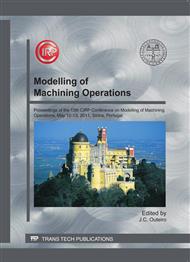[1]
P. Oppelt, M. Fischbacher and C. Zeppenfeld: Process Relations and Machine Requirements on Speed Stroke Grinding of Turbine Materials, Fortschritt-Berichte VDI Reihe 2 Fertigungstechnik, Proceeding of the 1st European Conference on Grinding, VDI Verlag Duesseldorf, pp.1-1 – 1-17 (2003)
Google Scholar
[2]
C. Zeppenfeld: Schnellhubschleifen von γ-Titanaluminiden, PhD-Thesis RWTH Aachen University (2005)
Google Scholar
[3]
M. Duscha, F. Klocke and H. Wegner: Residual Stress Model for Speed Stroke Grinding of Hardened Steel, Proceedings of 4th CIRP International Conference on High Performance Cutting, Gifu, Japan, p.437 (2010)
Google Scholar
[4]
H. Carslaw and J.C. Jaeger: Conduction of heat in solids, Oxford Science Publications, Oxford University Press (1959)
Google Scholar
[5]
M. Mahdi and L.C. Zhang: Computers and Structures Vol. 56 (1995) No.2/3, p.313
Google Scholar
[6]
A. Aguiar, A. Monteiro, R. Natal and M.P. Lages: COMPLAS VIII p.1 – 4 (2005)
Google Scholar
[7]
L. Wang, Y. Qin, Z-c. Liu, P-q. Ge, W. Gao: Journal of Engineering Manufacture Vol. 217 (2003) No. 7, p.953
Google Scholar
[8]
Q. An, Y. Fu and J. Xu: Key Engineering materials Vol. 416 (2009), p.514
Google Scholar
[9]
E. Brinksmeier, C. Heinzel, C. Böhm and T. Wilke: Production Engineering - Research and Development Vol. 10 (2003) No. 1, p.9
Google Scholar
[10]
M. Duscha, F. Klocke, A. D'Entremont, B. Linke, H. Wegner: Proceedings in Manufacturing Systems Vol. 5 (2010) No. 3, p.143
Google Scholar
[11]
J.C. Aurich, D. Biermann, H. Blum, C. Brecher, C. Carstensen, B. Denkena, F. Klocke, M. Kröger, P. Steinmann and K. Weinert: Production Engineering - Research and Development Vol. 3 (2009) No. 1, p.111
DOI: 10.1007/s11740-008-0137-x
Google Scholar
[12]
I.-D. Marinescu, W.B. Haber, B. Dimitrov and I. Inaski: Tribology of abrasive machining processes, Chapter 6: Thermal design of processes, p.177 – 238 (2004)
DOI: 10.1016/b978-081551490-9.50007-4
Google Scholar
[13]
T. Jin and D. Stephenson: Manufacturing Technology Vol. 53 (2004) No.1, p.259
Google Scholar
[14]
D. Stephenson and T. Jin: Physical basics in grinding. 1st European Conference on Grinding, Aachen, 6.-7. November, Fortschritts-Berichte, VDI-Reihe 2, Nr. 643, VDI Verlag, pp.1301-1321 (2003)
Google Scholar
[15]
S. Malkin: Grinding Technology: Theory and application of machining with abrasives, Chichester: Ellis Horwood (1989).
Google Scholar
[16]
B. Maier: Beitrag zur thermischen Prozessmodellierung des Schleifens, PhD-Thesis RWTH Aachen University (2008)
Google Scholar
[17]
T.-D Howes, K. Neailly and A.-J. Harrison: Annals of the CIRP Vol.37 (1987) No. 1, p.223
Google Scholar
[18]
R.-S Hahn: Proceedings 3rd Int. Machine Tool Design and Research Conference, Birmingham, p.129 (1962)
Google Scholar
[19]
S. Kohli, C. Guo and S. Malkin: Journal of Engineering for Industry Vol. 117 (1995) No. 2, p.160
Google Scholar
[20]
C. Guo, Y. Wu, V. Varghese and S. Malkin: Annals of the CIRP Vol. 48 (1999) No. 1, p.247
Google Scholar
[21]
W.B. Rowe, S. Black, E. C., B. Mills, M.N. Morgan and H.S. Qi: Annals of the CIRP Vol. 44 (1995) No. 1, p.329
Google Scholar
[22]
N.K. Kim, C. Guo and S. Malkin: Annals of the CIRP, Vol. 46 (1997) No. 1, p.227
Google Scholar
[23]
J. Li, J.C.M. Li: Material Science and Engineering A 409, p.108 (2005)
Google Scholar
[24]
H. Hamdi, H. Zahouani and J.M. Bergheau: J. Mater. Process. Technol. 147, p.277 (2004)
Google Scholar
[25]
T. Jin and D.J. Stephenson: Annals of the CIRP Vol. 53 (2004) No. 1, p.259
Google Scholar
[26]
A. Brosse, P. Naisson, H. Hamdi and J.M. Bergheau: Journal of Materials Processing Technology Vol. 201 (2008), p.590
DOI: 10.1016/j.jmatprotec.2007.11.267
Google Scholar
[27]
T. Jin and D.J. Stephenson: International Journal of Machine Tools and Manufacturing Vol. 46 (2006), p.1862
Google Scholar
[28]
D.H. Zhu, B.Z. Li and J.G. Yang: ASME Conf. Proc. IMECE2008, Nov 2 – 6, 2008, Boston, Vol. 10 (2008), p.1793
Google Scholar
[29]
H.J. Kim, N.K. Kim and J.S. Kwak: International Journal of Machine Tools and Manufacture, Vol. 46 (2006), p. (2086)
Google Scholar
[30]
K. Weinert and M. Schneider: Annals of the CIRP, Vol. 49 (2000) No. 1, p.253 ff
Google Scholar
[31]
T. Kato and H. Fuji: Journal of Manufacturing Science and Engineering, ASME, Vol. 122 (2000), p.297 ff
Google Scholar
[32]
X. Xu and S. Malkin: Journal of Manufacturing Science and Engineering, Vol. 123 (2001) No. 2, p.191 ff
Google Scholar
[33]
F. Klocke and B. Linke: Research and Development, Vol.2 (2008), p.157 ff
Google Scholar


